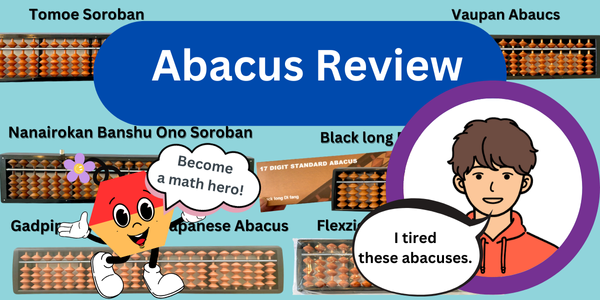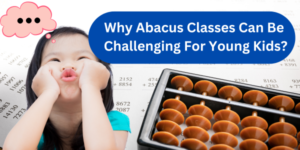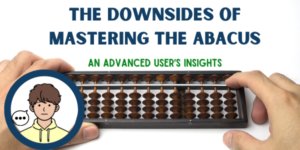When you look at Amazon, you will see many different types of abacuses. If you have never learned to use one, you may not know how to find the right one for you or your child. Since I often receive questions about which abacus to buy for my Japanese abacus tutorial lessons, I would like to share my thoughts and reviews on the abacuses I have tried.

This Japanese-made Nanairorikan Banshu-Ono abacus is the one I currently use. When I first started learning abacus, I used a different Japanese-made abacus (Tomoe) without a reset button. It was also a great abacus. However, once I began participating in abacus competitions, I switched to an abacus with a reset button to increase my speed. This particular abacus has 23 digits and includes a reset button. I like this abacus very much primarily because of its smooth and precise bead movement.
People often ask me about the difference between wooden and plastic beads. Wooden beads feel more natural and do not hinder movement, functioning almost as an extension of your fingertips. Additionally, the upper frame of this abacus is triangular, making it easy to grip, and the lower frame has my name engraved on it.
This abacus is a specialty product of Ono, Hyogo Prefecture, which is also designated as a traditional craft in Japan. The production of a Yashuu Abacus involves more than 100 processes, most of which are handmade and require delicate work. Each abacus is carefully crafted with skilled techniques that boast tradition and history. The abacus is assembled with delicate traditional techniques, making it easy to use. The beads are not only looking good but also being a true work of wooden craftsmanship.
The cost of this abacus is about $100 (as of 05/24), with embroidery costing extra. This abacus is great for intermediate to advanced learners. Unfortunately, this abacus is not available on Amazon.com.

This is my first abacus, the Tomoe Soroban. It’s a 23-digit abacus with wooden beads. I bought it in Japan, but you can now find a similar one on Amazon for about $32. It’s a great abacus with smooth operation. It’s light but sturdy, making it wonderful for beginners to intermediate learners unless you plan to compete in abacus competitions.
There’s also a 15-digit Tomoe abacus available on Amazon, but the price is the same as the 23-digit version (or even higher!). The Tomoe Soroban with a reset button, called One Touch, is sold for $55. I think this is the best choice if you want a 23-digit, Made in Japan abacus with a reset button.

This Vaupan abacus has 17 digits and a reset button. I’m not sure where this abacus is manufactured. The beads are made of ABS plastic, and the ones I received had some rough tips. However, this abacus operates more smoothly and feels sturdier compared to other abacuses with plastic beads. It doesn’t feel as lightweight as typical plastic bead abacuses. It has nice bead movement, almost like wooden bead abacuses.
While I am not sure if the rod of each column is made of real bamboo or wood (it feels like it), I believe that’s why it stands out among plastic bead abacuses. The bead size is also similar to Japanese-made abacuses, and the price is just $8! This makes it a great choice for anyone unsure about learning abacus and wanting to give it a try. Finding an abacus with a reset button at this price is almost impossible!
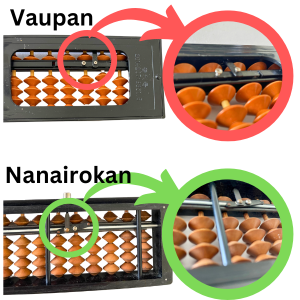
However, I do have one concern about the reset button. Take a look at the picture comparing the back side of this abacus and my Nanairokan abacus. While the reset button on the Nanairokan abacus is well-attached and works smoothly, the Vaupan abacus’s reset button screws don’t seem to be fully screwed in. I wonder how long the reset button will last. That’s my only concern. Other than that, I think this is a good choice for beginners.

This Black Long Di Fang 17-digit standard abacus is made with ABS plastic beads and doesn’t have a reset button. It’s made in China. It’s a good option for beginners because of its cost and functionality. However, the plastic beads are very light, and you might find it a bit strange if you switch to wooden beads later on. The rhythm and sound of the beads are quite different from those of wooden beads.
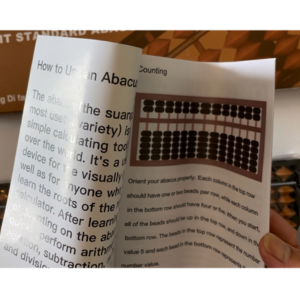
In terms of price and function, this abacus is pretty typical of what you’ll find on Amazon for plastic bead abacuses. One thing that surprised me was the instruction booklet that came with it. It’s for a Chinese abacus, or suanpan, which has 2 upper beads and 5 lower beads. It’s a bit odd since the abacus itself is Japanese-style, but the instructions are for a Chinese abacus. This abacus is sold on Amazon for $10.

This Gradiparty Chinese-Japanese abacus has 23 digits with plastic beads. While it’s labeled as both “Chinese” and “Japanese,” which are very different styles, the abacus itself is Japanese-style with 1 upper bead and 4 lower beads. The listing description is quite confusing, mixing terms like “Chinese Japanese abacus,” “wooden abacus,” and “vintage style” – it seems like they’re trying to include all the abacus keywords!
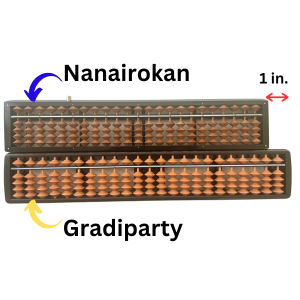
The plastic beads are a bit larger. As you can see in the picture, this abacus is about an inch larger than my other 23-digit abacus. The beads are very light and make loud plastic sounds. It’s sold for $13 on Amazon. I don’t recommend this abacus because you might find it strange to switch to a 23-digit abacus with wooden beads later on.

Excuse the photo of this abacus in its plastic bag – I didn’t want to open it so I could return it to Amazon. This Flexzion Soroban Abacus has 17 digits with ABS plastic beads and is sold for $12 on Amazon. Among the abacuses I have reviewed here, this one is quite different from the standard Japanese abacus.
Each bead is much larger and rounder, whereas typical abacus beads have an “edge” for a good grip. This abacus looks more like a toy to me. If your purpose in buying an abacus is just to play around, this might be perfect. Since all the materials are plastic, you don’t have to worry about it getting wet or dirty. However, if your goal is to learn the Japanese abacus, I think other abacuses would be better suited for your needs.
In summary, choosing the right abacus depends on your child’s needs. While Tomoe Soroban or Unshudo Made in Japan Soroban are highly recommended for Japanese abacus learning, it’s also a good idea to start with a small investment in an abacus with plastic beads.
I introduced my abacus school to some of my friends, but not all of them lasted or even started. While I’m confident that the abacus helps develop early math skills, it’s important to recognize that it’s not suitable for everyone.

